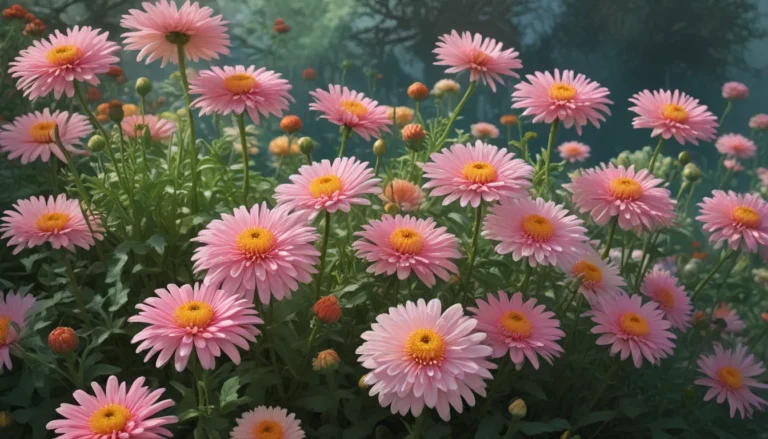A Comprehensive Guide to Growing and Caring for Snapdragon Flowers

Unlocking the Magic of Antirrhinum Majus
Let’s dive into the fascinating world of growing and caring for snapdragon flowers, scientifically known as Antirrhinum majus. Originating from Mediterranean Europe, these vibrant blossoms earned their whimsical name due to their blossoms that resemble the mouth of friendly dragons opening and closing.
Snapdragon plants thrive in cool weather conditions as a tender perennial in USDA Hardiness Zones 7 to 10 and as annuals in other temperate regions. These unique flowers belong to the Antirrhinum genus, which is the benchmark plant within the genus. With approximately 20 species under its umbrella, including some from North America and northern Africa, snapdragons are a diverse and captivating addition to any garden.
In this detailed guide, we will explore everything you need to know about successfully cultivating and nurturing snapdragon flowers in your garden.
What You Will Discover
In this comprehensive guide, you will uncover various aspects of growing and caring for snapdragon flowers, including:
- Cultivation and History
- Propagation
- How to Grow
- Growing Tips
- Maintenance
- Cultivars to Select
- Managing Pests and Disease
- Best Uses
- Quick Reference Growing Guide
Ready to embark on an enlightening journey into the world of snapdragon flowers? Let’s get started!
Cultivation and History
Snapdragon plants thrive during the cool late spring to early summer period of the growing season, with their vigor diminishing as temperatures rise above 80°F. Cultivating snapdragon flowers offers a plethora of options, as they come in three sizes:
- Dwarf
- Intermediate
- Tall
With a multitude of colors to choose from, thanks to the extensive hybridization by plant breeders, snapdragons are available in hues ranging from orange, peach, and pink to purple, red, white, and yellow, as well as captivating bicolor and tricolor combinations. One unique trait of snapdragon flowers is their clumping growth habit, squarish stems, and lance-shaped green leaves, with flower buds opening sequentially from the stem’s bottom to the terminal tips.
Deadheading spent flower stems and cutting stems for vase use can prolong blooming in cooler regions, while a midseason cutback in warmer areas may encourage re-foliating and produce a second late-season bloom. Snapdragons hold historical significance, as the botanical name “Antirrhinum majus” originates from Greek, with “Anti” meaning like and “rhis” translating to snout, a fitting description of its bilabiate, two-lipped flower that mimics a dragon’s mouth.
Propagation
To propagate snapdragons, you can opt for disease-resistant seeds or nursery plants from reputable sources, or consider propagating them from stem cuttings. Seed propagation, suitable for Zones 7 to 10, involves pre-seeding in the fall for blooms in spring or sowing seeds directly in spring, with maturity expected in 80 to 100 days.
Starting from seeds, seedlings, or cuttings offers multiple avenues for cultivating vibrant snapdragon flowers that will enhance your garden’s beauty.
From Seed
To initiate seed propagation, choose a sunlit location with well-draining soil, sprinkle seeds over the surface without covering them, and maintain even moisture during germination. Transplant seedlings to the garden or containers after the danger of frost has passed, ensuring they receive sufficient care and attention for optimal growth.
From Cuttings
Taking cuttings from mature plants, while challenging, presents another propagation method that can yield successful results with proper care and attention throughout the rooting process.
From Seedlings/Transplanting
Transplanting nursery plants or hardening off seedlings allows for a seamless integration of snapdragons into your garden, with proper watering, spacing, and care contributing to healthy plant development.
How to Grow
Optimal growing conditions for snapdragons include full sun exposure, well-draining organic-rich soil, and regular watering techniques to maintain soil moisture levels essential to plant growth. Fertilization, spacing, and plant care practices all play vital roles in ensuring healthy growth and vibrant blooms from your snapdragon plants.
Growing Tips
When embarking on the cultivation journey with snapdragons, keep the following tips in mind for a successful and rewarding gardening experience:
- Initiate seed starting in regions with hot summers to allow for bloom before rising temperatures.
- Surface sow seeds to provide adequate light for germination.
- Follow recommended spacing guidelines to promote optimal air circulation and minimize humidity levels, preventing fungal growth.
- Practice seed collection in temperate climates for subsequent year plantings.
Maintenance
Maintenance of snapdragon flowers involves basic tasks such as pinching growing tips, deadheading spent blooms, and occasional midseason cutbacks to stimulate additional blooming. Regular weeding, mulching, and fertilization are integral components of snapdragon care that contribute to healthy plant growth and blooming throughout the season.
Follow these maintenance practices to promote vibrant, healthy snapdragon blooms in your garden.
Cultivars to Select
An array of snapdragon hybrids is available in captivating colors and unique varieties, offering gardeners a diverse selection suitable for various garden settings and environments. Rust-resistant cultivars stand out as ideal choices due to their resilience against common fungal threats, ensuring a healthy and flourishing plant collection.
Explore different snapdragon cultivars such as ‘Brighton Rock,’ ‘Magic Carpet,’ ‘Rocket,’ and ‘Snowflake,’ each showcasing distinct color palettes, heights, and characteristics that add a touch of charm and elegance to any garden space.
Managing Pests and Disease
Despite the best care practices, snapdragons may be susceptible to pests and diseases that require vigilance and proactive measures for prevention and control. Common pests such as aphids, cutworms, and mites can pose challenges to snapdragon plants, while diseases such as rust, anthracnose, and mildew may affect plant health.
Implement organic pest control methods and preventive measures to combat common snapdragon pests and diseases, ensuring your plants remain healthy and vibrant throughout the growing season.
Best Uses
Snapdragon flowers serve as versatile additions to garden landscapes, offering vibrant colors, alluring textures, and vertical accents that appeal to pollinators and human admirers alike. From container plantings and window boxes to beds, borders, and cutting gardens, snapdragons find their place in a variety of garden settings, blending seamlessly with companion plants and floral arrangements.
Incorporate snapdragons into your garden design to enhance visual appeal, attract pollinators, and create a dynamic interplay of colors and textures that elevate your outdoor space.
Quick Reference Growing Guide
Plant Type: Annual, tender flowering perennial
Flower/Foliage Color: Bicolor, orange, peach, pink, purple, red, tricolor, white, yellow/green
Native to: Mediterranean Europe
Tolerance: Deer
Hardiness (USDA Zone): 7-10
Soil Type: Organically rich
Bloom Time: Spring to frost
Soil pH: 6.2-7.0
Exposure: Full sun
Soil Drainage: Well-draining
Spacing: 6-12 inches
Attracts: Bees, butterflies, hummingbirds
Planting Depth: Surface sow (seeds)
Companion Planting: Cosmos, daisies, marigolds, petunias, sweet William, zinnias
Height: 8-36 inches, depending on variety
Uses: Beds, borders, containers, cottage gardens, cutting gardens, mixed groupings, window boxes
Spread: 6-12 inches, depending on variety
This quick reference guide offers valuable insights into the key aspects of growing and caring for snapdragon flowers, helping you make informed decisions and cultivate healthy, vibrant plants in your garden.
Embrace the Beauty of Snapdragon Flowers
Snapdragon flowers, with their enchanting colors, unique shapes, and vibrant blooms, add a touch of magic to any garden landscape. By following the cultivation, care, and maintenance tips outlined in this guide, you can nurture healthy, thriving snapdragon plants that enhance the beauty and charm of your outdoor space.
Ready to embark on your snapdragon growing journey? Share your experiences, questions, and insights in the comments section below. Let’s celebrate the allure and elegance of snapdragon flowers together!
If you found this guide informative and insightful, check out our recommended articles on flower cultivation and gardening practices to expand your knowledge and enhance your gardening skills.
Unlock the potential of your garden with the captivating beauty of snapdragon flowers and create a vibrant, colorful landscape that brings joy and inspiration to all who behold it. Happy gardening!





